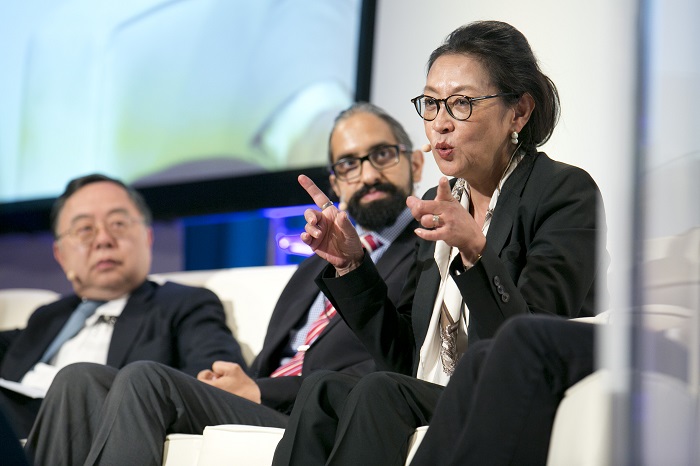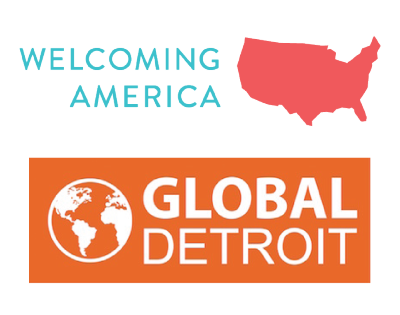Guest Post: Celebrating Immigrant Heritage, Building Shared Futures in Global Cities
By Sara McElmurry, The Chicago Council on Global Affairs

Chicago Council on Global Affairs
Chicago’s ambitions to be “the most immigrant-friendly city in the world” made it a suitable setting for rich conversations about cultural heritage and inclusion at the Chicago Forum on Global Cities on June 1-3, timed perfectly with the kickoff of Immigrant Heritage Month, a nationwide celebration of our shared heritage of diverse cultures.
Forum panelist Ronnie Chan, chairman of the Hong Kong-based Hang Lung Group, eloquently framed the theme at one of the Forum’s opening plenaries, reflecting on how the soul of a city is shaped by the generations of diverse people who have migrated through it.
That’s certainly the case for Chicago, whose unique character comes complements of those who came here from somewhere else. Much of Chicago’s mosaic of neighborhoods—Chinatown, Greektown, Little Italy, and Ukrainian Village—still bears the names of its original ethnic inhabitants. The city’s iconic foods have immigrant roots: deep dish pizza evolved out of the culinary traditions of Neapolitan immigrants, Chicago-style hot dogs from German-born residents. Chicago is home to a slew of cultural institutions—from the National Hellenic Museum to the Polish Museum of America to the National Museum of Mexican Art—that speak to the importance of the city’s immigrant heritage on countrywide level.
If cities’ souls are shaped by their past generations of immigrants, it is important to recognize that their futures—their economy and their demography—will be formed by their ability to embrace forthcoming waves of newcomers.
Critical conversations about immigrant integration and inclusion are too often challenged by today’s hyper-polarized climate of a worldwide refugee crisis, global security concerns around terrorism, and intense anti-immigrant rhetoric in the United States, Europe and beyond. But global cities—ports of entry for immigrants across the world, often more nimble and pioneering in creating integration programs and policies that their federal governments—are well-suited to be the world’s laboratories in developing and sharing best practices in this area:
- In the Gulf States, cities are championing the building of cultural institutions as “connectivity hubs” in uniting people in countries where more than 90 percent of the population is foreign-born. Sultan Sooud Al Qassemi, an Abu Dabi-based journalist, spoke about how the city’s art museums provide a means for people from diverse cultures to converge. Experiencing each other’s art “detoxifies tensions and reinforces a shared sense of humanity,” he said.
- In Germany, where the federal government is struggling to serve 1.5 million refugees, the city of Hamburg has successfully mobilized a network of local volunteers to welcome the more than 61,000 refugees who entered the city last year alone. “It’s not just the state who is responsible for the care and education [of refugees],” said Dorothee Stapelfeldt, Minister for Urban Development and Housing in Hamburg. “There are many volunteers who are going to refugees, talking to them, inviting them to coffee, tea, cakes, and playing with the children. You need a society to care about refugees.”
- In Chile, metro-level investments in infrastructure are addressing the economic inequality that plagues the country, which disenfranchises newcomers and native Chileans alike. “My job is to convince the ‘haves’ that the problems of the ‘have-nots’ are their problems,” said Claudio Orrego, governor of the metropolitan region of Santiago. Governor Orrego has championed innovative investments in infrastructure—Santiago’s best library is in one of the city’s poorest neighborhoods, for example—to create a shared sense of ownership in the city’s future.
While global cities have relatively deep pockets and large platforms to carry out their efforts, some of the most innovative work in immigrant integration is being done in smaller communities across the cash-strapped Midwest where aging populations and stagnating economies stand to benefit greatly from an influx of youthful, working-age immigrants.
The Chicago Council on Global Affairs studied the incredible momentum of these regional initiatives in its 2014 “Reimaging the Midwest” paper, which highlighted the efforts of places like Detroit, Minneapolis, and Cincinnati in establishing immigrant welcoming efforts out of their mayor’s offices, and smaller communities like Grand Island, Nebraska—population 50,000—which offers citizenship classes, health fairs, translation services, and cultural awareness events to immigrants and native-born residents alike. Chicago, for its part, offers citizenship services in libraries, provides supports for undocumented students in public schools, and provides resources to immigrant entrepreneurs.
Big or small, cities are filling the gaps created by stalled action on immigration at the federal level in the United States.
Edward Glaeser, a faculty member at Harvard University, spoke about how “cities are good for immigrants and immigrants are good for cities” in a Forum plenary around building economic equality and vibrancy in the world’s global cities. Indeed, even as immigrants often come to cities in search of opportunity, their presence represents a demographic, economic and cultural lifeline in communities across the globe, both large and small.
As global cities celebrate the unique immigrant heritage that has shaped their “souls” this month, they’d be well-served also to do some soul searching on how they can best embrace newcomers and maximize their contributions. Against a growing global rhetoric around building walls and sealing national borders, global cities can—and should—lead a constructive conversation on extending welcomes and creating strong shared futures.
This post originally appeared on The Chicago Council on Global Affairs’ Global Insight.



